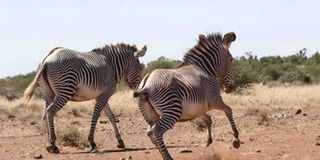Conservationists warn Grévy's zebra could become extinct

Grévy's zebras at Mpala Ranch in Laikipia County on December 28, 2017. The population of the species has been on the decline and conservationists have warned that it could become extinct. PHOTO | JOSEPH KANYI | NATION MEDIA GROUP
What you need to know:
- Grévy's zebra is strikingly beautiful and attracts thousands of high end tourists to Kenya.
- Lewa Conservancy and other conservationists have lined up a number of efforts to help protect the rare zebra.
- In 2017, poachers took advantage of the pastoralist invasions of Laikipia ranches to kill wild animals among them Grévy's zebras.
Conservationists have warned that Grévy's zebra, a rare species, is in danger of becoming extinct if urgent measures are not taken to protect it.
The population of Grévy's zebra that once roamed across various parts of Africa, has fallen dramatically from historical levels of 25,000 in the 1970s to about 2,350 today in the world.
The animal was found in six countries in Africa in the 1970s.
According to conservationists among them Lewa Conservancy’s Head of Conservation Geoffrey Chege, the Grévy's zebra is facing a serious risk of extinction due to increased poaching, diseases and limited access to grazing fields and water resources as a result of competition with livestock and predation by large animals like lions.
BEAUTIFUL SKIN
The Grévy's zebra is strikingly beautiful and attracts thousands of high end tourists to Kenya every year.
Conservationists say that the animal’s population continues to decline as they are killed because of their beautiful skins.
Mr James Wakibia, another conservationist, said a lot needs to be done to save the rare zebra from extinction.
However, Mr Chege revealed that Lewa Conservancy and other conservationists have lined up a number of efforts to help protect the rare zebra.
“In Lewa conservancy we have a team that ensures that the security of the Grévy's zebras is guaranteed. Establishment of community conservancies and restoration of Grévy's zebras ranges are among other efforts to save the rare species zebra,” disclosed Mr Chege.
Lewa Conservancy holds about 11 percent of Grévy's zebras in Kenya.
LAIKIPIA RANCHES
In 2017, poaching cartels took advantage of the pastoralist invasions of Laikipia ranches and conservancies to kill wild animals among them the endangered Grévy's zebras.
The invasions by pastoralists mainly from neighbouring Samburu, Isiolo and Baringo counties threatened wildlife in the renowned animal sanctuary.
Poachers disguising themselves as herders killed more than 1,000 wild animals in six months.
The menace cost the tourism industry in the region millions of shillings.
According to security managers and employees within the animal sanctuaries, hundreds of elephants, zebras and buffalos, among other animals, were killed.
RAPID DECLINE
Historically, the Grévy's zebra inhabited the semi-arid scrublands and plains of Somalia, Ethiopia, Eritrea, Djibouti, and Kenya in East Africa.
However, due to rapid decline in their population, they are now confined to the Horn of Africa, primarily Southern Ethiopia and Northern Kenya.
In Laikipia, they are found in conservancies including Loisaba, Suiyan and Mugie, among others.
The Kenyan government developed a plan in 2008 to conserve the remaining population of Grévy's Zebra.
It included the recognition of the need to work with traditional healers who use the zebra meat and fat to treat diseases such as tuberculosis.
The Grévy's zebra’s beauty is its undoing as it is hunted for its hide.





